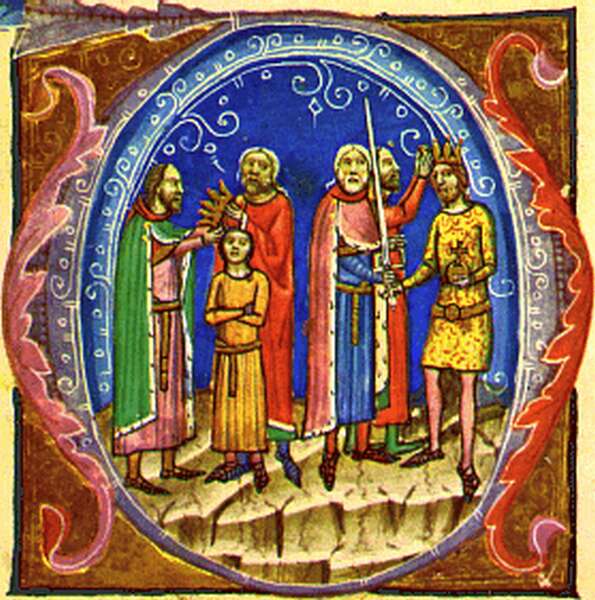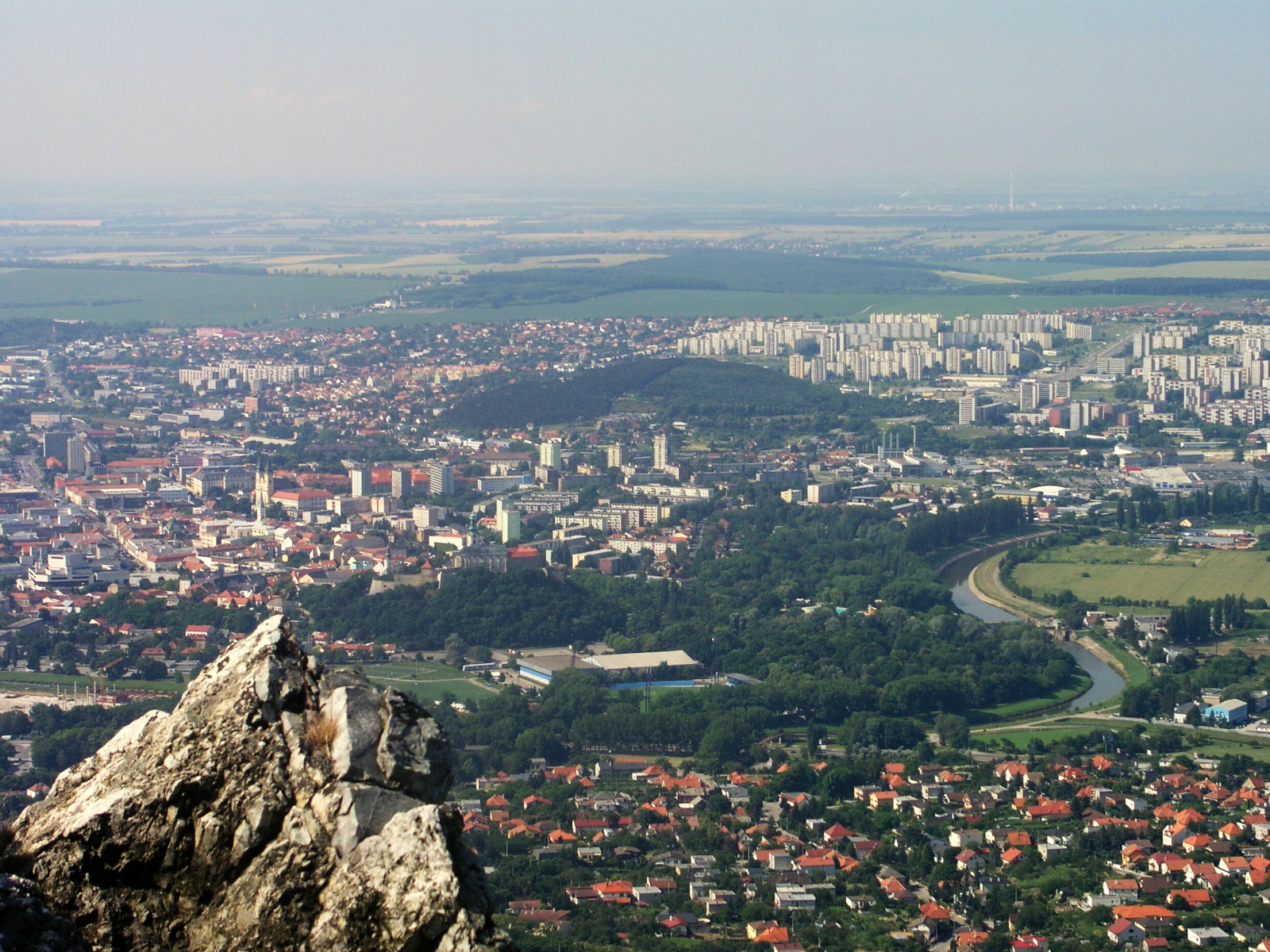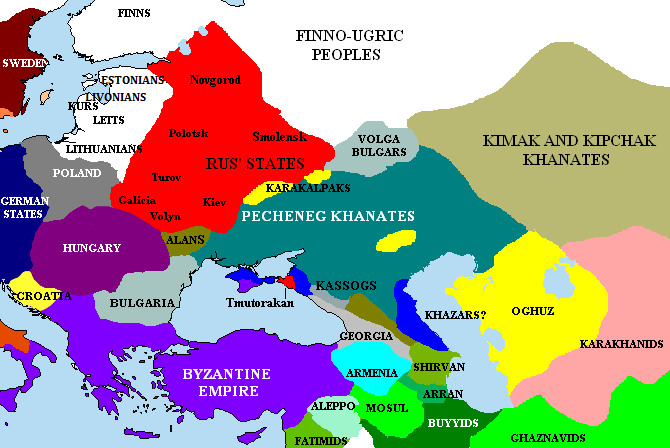|
Szent László
Ladislaus I ( hu, László, hr, Ladislav, sk, Ladislav, pl, Władysław; 1040 – 29 July 1095), also known as Saint Ladislas, was King of Hungary from 1077 and King of Croatia from 1091. He was the second son of King Béla I of Hungary and Richeza (or Adelaide) of Poland. After Béla's death in 1063, Ladislaus and his elder brother, Géza, acknowledged their cousin Solomon as the lawful king in exchange for receiving their father's former duchy, which included one-third of the kingdom. They cooperated with Solomon for the next decade. Ladislaus's most popular legend, which narrates his fight with a "Cuman" (a Turkic nomad marauder) who abducted a Hungarian girl, is connected to this period. The brothers' relationship with Solomon deteriorated in the early 1070s, and they rebelled against him. Géza was proclaimed king in 1074, but Solomon maintained control of the western regions of his kingdom. During Géza's reign, Ladislaus was his brother's most influential adviser. G ... [...More Info...] [...Related Items...] OR: [Wikipedia] [Google] [Baidu] |
Chronica Hungarorum
''Chronica Hungarorum'' (Chronicle of the Hungarians) is the title of several works treating the early History of Hungary, Hungarian history. Buda Chronicle A popular chronicle partly based on the ''Chronicon Pictum'' (entitled just ''Chronica Hungarorum'') was circulated in a printed form. It is also known as the ''Buda Chronicle''. It was produced in 1473 by András Hess and is the first incunabulum ever printed in Hungary (Buda, András Hess, 1473, 70 fol., 2º.) It relates the history of Hungary from the earliest times to the coronation of King Matthias. Eleven copies of the chronicle are known to survive, two of them in Hungary: one in the National Széchényi Library and another in the Budapest University Library. Thuróczy Chronicle The third chronicle entitled ''Chronica Hungarorum'', partly based on the ''Chronicon Pictum'', was produced by Johannes de Thurocz () , the first layman known to have written a book in the Kingdom of Hungary. This work (Brno, 1488, Augsbu ... [...More Info...] [...Related Items...] OR: [Wikipedia] [Google] [Baidu] |
Nitra
Nitra (; also known by other alternative names) is a city in western Slovakia, situated at the foot of Zobor Mountain in the valley of the river Nitra. It is located 95 km east of Bratislava. With a population of about 78,353, it is the fifth largest city in Slovakia. Nitra is also one of the oldest cities in Slovakia; it was the political center of the Principality of Nitra. Today, it is a seat of a ''kraj'' (Nitra Region), and an '' okres'' (Nitra District). Etymology The first mention of Nitra dates back to the 9th century. The name of the city is derived from the Nitra river. The name is Indo-European, but the question of its pre-Slavic or Slavic origin has not been satisfactorily answered. Nitra might be derived from the old Indo-European root ''neit-'', ''nit-'' meaning "to cut" or "to burn" using a derivation element ''-r-'' (see also slash-and-burn agricultural technique). The same root is still present in the Slovak verb ''nietiť'' (to make a fire), but also in othe ... [...More Info...] [...Related Items...] OR: [Wikipedia] [Google] [Baidu] |
Cumans
The Cumans (or Kumans), also known as Polovtsians or Polovtsy (plural only, from the Russian language, Russian Exonym and endonym, exonym ), were a Turkic people, Turkic nomadic people comprising the western branch of the Cuman–Kipchak confederation. After the Mongol invasion of Rus', Mongol invasion (1237), many sought Right of asylum, asylum in the Kingdom of Hungary, as many Cumans had settled in Hungary, the Second Bulgarian Empire playing an important role in the development of the state. Cumans played also an important role in (The Byzantine Empire, the Latin Empire, and the Empire of Nicaea, Nicaea Empire) Anatolia . Related to the Pecheneg, they inhabited a shifting area north of the Black Sea and along the Volga River known as Cumania, from which the Cuman–Kipchaks meddled in the politics of the Caucasus and the Khwarazmian Empire. The Cumans were fierce and formidable nomadic warriors of the Eurasian Steppe who exerted an enduring influence on the medieval Balkans. ... [...More Info...] [...Related Items...] OR: [Wikipedia] [Google] [Baidu] |
Pechenegs
The Pechenegs () or Patzinaks tr, Peçenek(ler), Middle Turkic: , ro, Pecenegi, russian: Печенег(и), uk, Печеніг(и), hu, Besenyő(k), gr, Πατζινάκοι, Πετσενέγοι, Πατζινακίται, ka, პაჭანიკი, bg, печенеги, pechenegi, bg, печенези, ; sh-Latn-Cyrl, Pečenezi, separator=/, Печенези, la, Pacinacae, Bisseni were a semi-nomadic Turkic ethnic people from Central Asia who spoke the Pecheneg language which belonged to the Oghuz branch of the Turkic language family. Ethnonym The Pechenegs were mentioned as ''Bjnak'', ''Bjanak'' or ''Bajanak'' in medieval Arabic and Persian texts, as ''Be-ča-nag'' in Classical Tibetan documents, and as ''Pačanak-i'' in works written in Georgian. Anna Komnene and other Byzantine authors referred to them as ''Patzinakoi'' or ''Patzinakitai''. In medieval Latin texts, the Pechenegs were referred to as ''Pizenaci'', ''Bisseni'' or ''Bessi''. East Slavic peo ... [...More Info...] [...Related Items...] OR: [Wikipedia] [Google] [Baidu] |
Kingdom Of Hungary
The Kingdom of Hungary was a monarchy in Central Europe that existed for nearly a millennium, from the Middle Ages into the 20th century. The Principality of Hungary emerged as a Christian kingdom upon the coronation of the first king Stephen I at Esztergom around the year 1000;Kristó Gyula – Barta János – Gergely Jenő: Magyarország története előidőktől 2000-ig (History of Hungary from the prehistory to 2000), Pannonica Kiadó, Budapest, 2002, , p. 687, pp. 37, pp. 113 ("Magyarország a 12. század második felére jelentős európai tényezővé, középhatalommá vált."/"By the 12th century Hungary became an important European factor, became a middle power.", "A Nyugat részévé vált Magyarország.../Hungary became part of the West"), pp. 616–644 his family (the Árpád dynasty) led the monarchy for 300 years. By the 12th century, the kingdom became a European middle power within the Western world. Due to the Ottoman occupation of the central and south ... [...More Info...] [...Related Items...] OR: [Wikipedia] [Google] [Baidu] |
Kingdom Of Croatia (925–1102)
The Kingdom of Croatia ( hr, Kraljevina Hrvatska; la, Regnum Croatiae), or Croatian Kingdom ( hr, Hrvatsko Kraljevstvo), was a medieval kingdom in Southern Europe comprising most of what is today Croatia (without western Istria and some Dalmatian coastal cities), as well as most of the modern-day Bosnia and Herzegovina. The Croatian Kingdom was ruled for part of its existence by ethnic dynasties, and the Kingdom existed as a sovereign state for nearly two centuries. Its existence was characterized by various conflicts and periods of peace or alliance with the Bulgarians, Byzantines, Hungarians, and competition with Venice for control over the eastern Adriatic coast. The goal of promoting the Croatian language in the religious service was initially introduced by the 10th century bishop Gregory of Nin, which resulted in a conflict with the Pope, later to be put down by him. In the second half of the 11th century Croatia managed to secure most coastal cities of Dalmatia with the c ... [...More Info...] [...Related Items...] OR: [Wikipedia] [Google] [Baidu] |
Saint Emeric Of Hungary
Emeric ( hu, Szent Imre herceg), also ''Emericus,'' ''Emerick, Emery, Emory'', and venerated as Saint Emeric (c. 1007 – 2 September 1031) was the son of King Stephen I of Hungary and Giselle of Bavaria. Life Family Emeric is assumedSauser, E., ''Biographisch-bibliographisches Kirchenlexikon'' (German, title transl. "Biographical-bibliographical encyclopaedia of the Roman Catholic church") Vol. XXI, pub. Bautz, 2003, to be the second son of Stephen I. Named after his maternal uncle Henry II, he was the only one of Stephen's sons who reached adulthood. Education Emeric was educated in a strict and ascetic spirit by the Benedictine monk from Venice, Gerard, from the age of 15 to 23. He was intended to be the next monarch of Hungary, and his father wrote his '' Admonitions'' to prepare him for this task. His father tried to make Emeric co-heir still in his lifetime. He married in the year 1022. The identity of his wife is disputed. Some say it was Irene Monomachina, a re ... [...More Info...] [...Related Items...] OR: [Wikipedia] [Google] [Baidu] |
Stephen I Of Hungary
Stephen I, also known as King Saint Stephen ( hu, Szent István király ; la, Sanctus Stephanus; sk, Štefan I. or Štefan Veľký; 975 – 15 August 1038), was the last Grand Prince of the Hungarians between 997 and 1000 or 1001, and the first King of Hungary from 1000 or 1001, until his death in 1038. The year of his birth is uncertain, but many details of his life suggest that he was born in, or after, 975, in Esztergom. He was given the pagan name Vajk at birth, but the date of his baptism is unknown. He was the only son of Grand Prince Géza and his wife, Sarolt, who was descended from a prominent family of '' gyulas''. Although both of his parents were baptized, Stephen was the first member of his family to become a devout Christian. He married Gisela of Bavaria, a scion of the imperial Ottonian dynasty. After succeeding his father in 997, Stephen had to fight for the throne against his relative, Koppány, who was supported by large numbers of pagan warriors. He defea ... [...More Info...] [...Related Items...] OR: [Wikipedia] [Google] [Baidu] |
Canonized
Canonization is the declaration of a deceased person as an officially recognized saint, specifically, the official act of a Christianity, Christian communion declaring a person worthy of Cult (religious practice), public veneration and entering their name in the canon catalogue of saints, or authorized list of that communion's recognized saints. Catholic Church Canonization is a Pope, papal declaration that the Catholic Church, Catholic faithful may Veneration, venerate a particular deceased member of the church. Popes began making such decrees in the tenth century. Up to that point, the local bishops governed the veneration of holy men and women within their own dioceses; and there may have been, for any particular saint, no formal decree at all. In subsequent centuries, the procedures became increasingly regularized and the Popes began restricting to themselves the right to declare someone a Catholic saint. In contemporary usage, the term is understood to refer to the act by ... [...More Info...] [...Related Items...] OR: [Wikipedia] [Google] [Baidu] |
Investiture Controversy
The Investiture Controversy, also called Investiture Contest (German: ''Investiturstreit''; ), was a conflict between the Church and the state in medieval Europe over the ability to choose and install bishops (investiture) and abbots of monasteries and the pope himself. A series of popes in the 11th and 12th centuries undercut the power of the Holy Roman Emperor and other European monarchies, and the controversy led to nearly 50 years of conflict. It began as a power struggle between Pope Gregory VII and Henry IV (then King, later Holy Roman Emperor) in 1076. The conflict ended in 1122, when Pope Callixtus II and Emperor Henry V agreed on the Concordat of Worms. The agreement required bishops to swear an oath of fealty to the secular monarch, who held authority "by the lance" but left selection to the church. It affirmed the right of the church to invest bishops with sacred authority, symbolized by a ring and staff. In Germany (but not Italy and Burgundy), the Emperor ... [...More Info...] [...Related Items...] OR: [Wikipedia] [Google] [Baidu] |
Henry IV Of Germany
Henry IV (german: Heinrich IV; 11 November 1050 – 7 August 1106) was Holy Roman Emperor from 1084 to 1105, King of Germany from 1054 to 1105, King of Italy and Burgundy from 1056 to 1105, and Duke of Bavaria from 1052 to 1054. He was the son of Henry III, Holy Roman Emperor—the second monarch of the Salian dynasty—and Agnes of Poitou. After his father's death on 5 October 1056, Henry was placed under his mother's guardianship. She made grants to German aristocrats to secure their support. Unlike her late husband, she could not control the election of the popes, thus the idea of the "liberty of the Church" strengthened during her rule. Taking advantage of her weakness, Archbishop Anno II of Cologne kidnapped Henry in April 1062. He administered Germany until Henry came of age in 1065. Henry endeavoured to recover the royal estates that had been lost during his minority. He employed low-ranking officials to carry out his new policies, causing discontent in Saxony and Thurin ... [...More Info...] [...Related Items...] OR: [Wikipedia] [Google] [Baidu] |
Turkic Peoples
The Turkic peoples are a collection of diverse ethnic groups of West, Central, East, and North Asia as well as parts of Europe, who speak Turkic languages.. "Turkic peoples, any of various peoples whose members speak languages belonging to the Turkic subfamily...". "The Turkic peoples represent a diverse collection of ethnic groups defined by the Turkic languages." According to historians and linguists, the Proto-Turkic language originated in Central-East Asia region, potentially in Mongolia or Tuva. Initially, Proto-Turkic speakers were potentially both hunter-gatherers and farmers, but later became nomadic pastoralists. Early and medieval Turkic groups exhibited a wide range of both East Asian and West-Eurasian physical appearances and genetic origins, in part through long-term contact with neighboring peoples such as Iranian, Mongolic, Tocharians, Yeniseian people, and others."Some DNA tests point to the Iranian connections of the Ashina and Ashide,133 highlighti ... [...More Info...] [...Related Items...] OR: [Wikipedia] [Google] [Baidu] |







